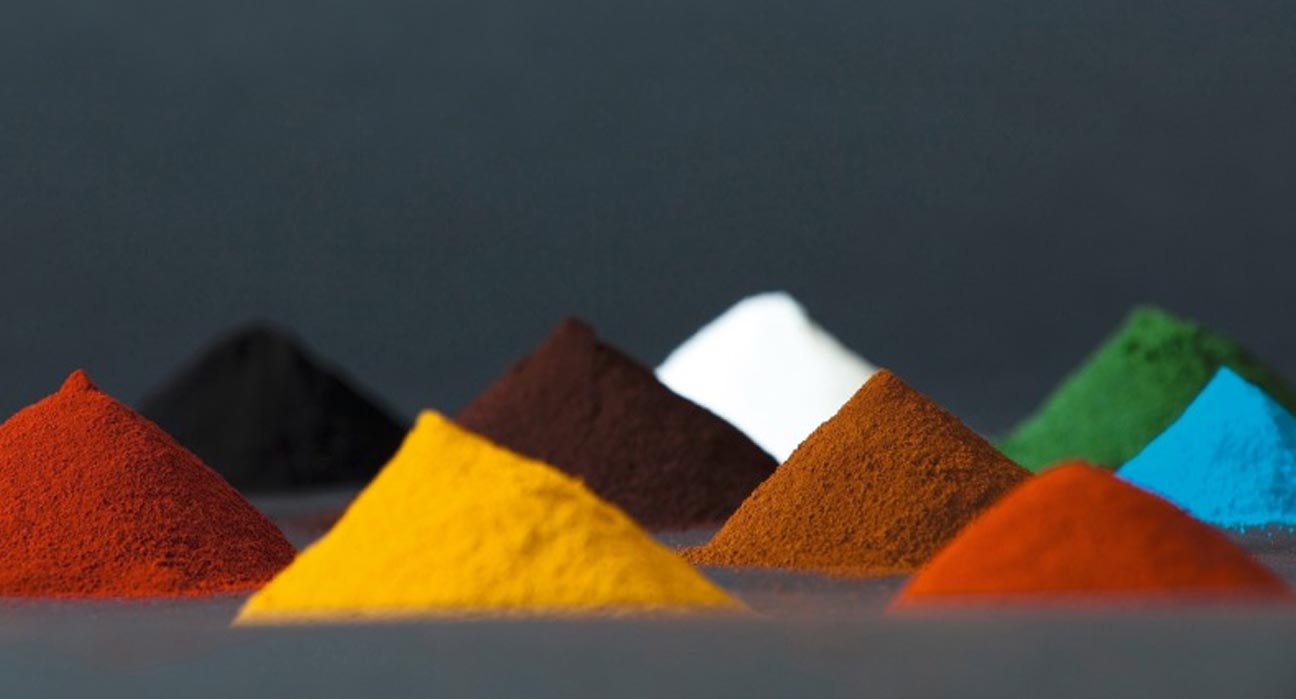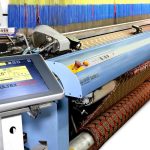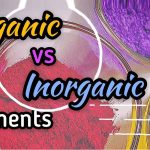This article is based on Inorganic pigment. That’s why, we are going to have a descriptive discussion over the definition, origin, classification, and Types, developments, economical assessment, etc. of Inorganic Pigments.
What is Pigment?
The term “Pigment” descends from the Latin word “pigmentum”; which was originally used in the sense of coloring matter.
Pigments are defined as substances consisting of small particles that are practically insoluble in an application system and are used as colorants.
Pigments are classified as Organic and Inorganic Pigments based on their method of formulation.
What is Inorganic Pigments?
Inorganic pigments, which have been widely used to impart colors in different compounds since time immemorial; are made up of mineral compounds and these minerals are mainly oxides, sulphides of one or more than one metals.
Inorganic pigments can be obtained from various natural mineral sources or minerals which have been obtained synthetically.
These pigments are heat resistant and possess strong coloring power; mainly applied in enamel, glass, ceramics, plastics, painting, high grade ink, high-end art pigment, permanently color patch, far-infrared materials, powder coating areas, etc. [2]
Origin & History
Ancient Period:
The history of inorganic pigments goes back to prehistoric times. Human beings in primitive societies were already able to color textiles, furs, and other things.
Over 60,000 years ago, ocher was used in the Ice Age as a coloring material. Natural manganese oxides and charcoal were used for black shades and iron oxides for yellow, orange, and red color tones.
The cave paintings of the Pleistocene peoples of southern France, northern Spain, and northern Africa were made with charcoal, ocher, manganese brown, and clays, and must have been produced over 30,000 years ago.
About 2000 BC, natural ocher was burnt, sometimes in mixtures with manganese ores, to produce red, violet, and black pigments for pottery.
Arsenic sulfide and Naples yellow (a lead antimonite) were the first clear yellow pigments. Ultramarine (lapis lazuli) and artificial lapis lazuli (Egyptian blue and cobalt aluminum spinel) were the first blue pigments. Terra vertex, malachite, were the first green pigments. Some phases of calcium sulfate, and kaolinite were the white pigments used at that time.
Painting, enamel, glass, and dyeing techniques reached an advanced stage of development in Egypt and Babylon. Certain types of chalk and clay were used as white pigments.
From the age of the migration of the peoples (fourth to sixth century AD) to the end of the late Middle Ages, there were no notable additions to the range of coloring materials. [4]
Renaissance and Modern Time:
New developments in the field of pigments first occurred during the early Renaissance. Carmine was introduced from Mexico by the Spanish.
In the 19th century, ultramarine, Gwinnet’s green, cobalt pigments, iron oxide pigments, and cadmium pigments were developed in quick succession.
In the 20th century, pigments increasingly became the subject of scientific investigation. In the past few decades, the synthetic colored pigments cadmium red, manganese blue, molybdenum red, and mixed oxides with bismuth came onto the market.
Titanium dioxide with rutile structures, and acicular zinc oxide were introduced as new synthetic white pigments and extenders, respectively.
Nowadays luster pigments (metal effect, pearl/luster, and interference pigments) have assumed increasing importance.
Inorganic Pigments
Classification & Types
Inorganic pigments can be classified from various points of view. As a recommendation for ISO and DIN, we can classify inorganic pigments into four main groups, based on coloristic and chemical considerations. Those are;-
- White Pigments
- Black Pigments
- Colored Pigments &
- Special Pigments
White pigments are represented by titanium dioxide (rutile and anatase), zinc sulfide including lithopone, and zinc oxide.
Colored pigments show the broadest variation, ranging from blue (mixed metal oxides, ultramarine, and iron blue) via green (chromium oxide, mixed metal oxides) and yellow (iron hydroxide, mixed metal oxides, chromates, cadmium sulfide) up to red (iron oxide, cadmium selenide, molybdates, cerium sulfide, oxonitrides).
The main representative for black pigments is carbon black. Based on this variety of colors, whites and blacks, with inorganic pigments it is possible to design nearly all thinkable colors and non-colors (white, black, and gray), including bright and dark color shades, by the use of pure single pigments or pigment mixtures. [5]
Special pigments are subdivided in the classes effect pigments (luster pigments), with the two subclasses special effect pigments (pearlescent pigments, interference pigments) and metal effect pigments, transparent pigments, luminescent pigments, with the two subclasses fluorescent pigments and phosphorescent pigments, magnetic pigments, and anticorrosive pigments.
The last two classes, as well as some of the transparent pigments, belong to the category of functional pigments. Other materials that count as functional pigments are electrically conductive, IR reflective, UV absorbing, and laser marking pigments.
Inorganic Pigments Properties
Inorganic pigments consist of single particles of mostly uniform chemical composition and crystal structure. The interaction of pigment particles with visible light is decisive for the appearance of pigments in their pure powdered form and in the particular application medium.
Optimal Properties:
The optical characteristics of pigmented systems are determined by:-
– Pigment properties such as particle size, particle size distribution, particle shape, refractive index, scattering coefficient, absorption coefficient
– The properties of the application system (binder) such as refractive index, self-absorption
– The pigment volume concentration (PVC) in the pigmented system
– The hiding power of the pigments used, for white pigments in addition the tinting strength, for black pigments in addition the color strength.
Color properties:
When light strikes the surface of a pigmented system, e.g., a pigmented film, three different events may occur:
– Light absorption by the pigment particles (in the case of a colored or black pigment)
– Diffuse reflection of light at the pigment particles (scattering) or in specific cases (effect pigments) directed reflection
– The light passes the pigmented medium without further interaction (no striking of pigment particles, the binder is assumed to be transparent and nonabsorbent).
Application and Uses
The most important areas of use of inorganic pigments are paints, varnishes, plastics, artists’ colors, printing inks for paper and textiles, leather decoration, building materials (cement, renderings, concrete bricks and tiles, mostly based on iron oxide and chromium oxide pigments), imitation leather, floor coverings, rubber, paper, cosmetics, ceramic glazes, and enamels.
Criteria for Application
The choice of a pigment for a specific application includes several criteria to achieve an optimal application result:
– Color properties: color, tinting strength, lightening power, hiding power
– General chemical and physical properties: chemical composition, particle size, particle size distribution, density, moisture and salt content, content of water-soluble etc.
– Stability properties: resistance against the light (especially UV light), heat, humidity, and chemicals, retention of gloss, corrosion resistance
– Behavior in binders and other application systems: dispersion properties, interaction and compatibility with binder components solidifying properties.
New Developments
Notwithstanding that most inorganic pigments have been known for a very long time, new developments appear on the catwalk of colors. The so-called “high performance pigments
Driven by environmental laws, even some of the former important inorganic pigments have had to be replaced. For example, red lead was fully substituted in most countries in anticorrosion paint. However environmental considerations are not the only driving force in the development of new pigments.
The invention of new pigments and the improvement of the already existing pigments in this class in the last decade have made new color effects available on an industrial scale.
There are still challenges: Brilliant, inorganic, nontoxic, stable and cheap green or blue pigments are amongst these and will be developed with the passage of time.
Market Size & Economic Aspects
The global inorganic color pigments market size was valued at USD 3.10 billion in 2019. It is expected to expand at a compound annual growth rate (CAGR) of 3.0%, in terms of revenue, from 2020 to 2027.
The market is expected to be driven by the growing application of inorganic color pigments in plastics, paints and coatings, and printing inks. Inorganic color pigments are used to provide color to the substrate by blending them or by applying as a coating on the surface.
These pigments are produced by mixing metal oxides with the help of simple chemical reactions such as oxidation and high-temperature calcination procedure. Because of their composition, inorganic color pigments offer high tinting strength, excellent light and weather fastness, excellent resistance towards solvent and oxidizing agent, heat stability, and consistency.
The growing demand for surface treatment activity along with a rising preference for better aesthetics across numerous industries including construction, automotive, medical, and cosmetics, is expected to drive the market growth over the forecast period.
Growing construction activities and significant development in automotive industries in various developing and developed countries such as the U.S., India, China, Germany, the U.K., and other European countries have resulted in increased demand for plastics and paints and coatings in recent years.
Emerging regions such as the Asia Pacific and the Middle East and Africa have witnessed strong growth in non-residential sectors, including FMCG, IT, telecom, and retail which is further fuelling the demand for plastics and paints and coatings products.
Thus, the positive aspect of the paint and coating market coupled with the rising application of plastics to reduce the overall weight, better design, and aesthetics in the automotive industry is anticipated to boost the market demand in the coming years.
Conclusion
The application of pigments for colorations is considered to be among the oldest cultural activities of mankind. Inorganic pigments have a huge area of application because of their anticorrosive or magnetic properties. Important sectors are automotive and industrial coatings, paints, plastics, printing inks, cosmetic formulations, and construction materials.
Researchers are trying their level best to develop inorganic pigments to fulfill the human desire. We expect, in future, we will have an era of innovative inorganic pigments and their border uses.
References
| [1] | G. Pfaff, Inorganic Pigments. |
| [2] | A. Hossain. Assignment on Inorganic Pigments |
| [3] | D. B. W. G. Judd, Color in Business, Science and Industry,, 1975. |
| [4] | G. P. Gunter Buxbaum, Industrial Inorganic Pigments. |
| [5] | G. S. W. S. W. I. yszecki, Color Science,, New York,, 2000. |
| [6] | H. M. (. Smith, High Performance Pigments, Wiley-VCH, Weinheim, 2002. |
| [7] | (. R. McDonald), Colour Physics for Industry, Society of Dyers and Colourists, 1997. |
| [8] | H. G. Völz, Industrial Color Testing Fundamentals and Techniques, Wiley VCH, Weinheim, 2001. |
| [9] | “Organic vs Inorganic Pigments,” Kolor Jet Chemical Pvt. Ltd., [Online]. Available: https://www.dyes-pigment.com/organic-vs-inorganic-pigments.html. |
| [10] | “Inorganic Color Pigments Market Size, Share & Trends Analysis Report,” GRAND VIEW RESEARCH, 2020. |





